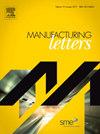High-speed robotic friction stir lap welding of three stack aluminum alloy assembly for automotive applications
IF 1.9
Q3 ENGINEERING, MANUFACTURING
引用次数: 0
Abstract
We present the first experimental demonstration of high-speed (1 m/min) robotic friction stir lap welding for three-sheet (3T) stack-ups of both similar and dissimilar aluminum alloys, including wrought and cast forms. The mechanical performance of the joints under lap shear, T-peel, and U-peel/KSII loading were evaluated. A novel U-peel/KSII configuration, applied for the first time for linear joints demonstrates the role of stitch welds in arresting crack growth. These results establish the feasibility of using robotic FSLW for complex, high-volume automotive structures while maintaining high weld quality at industrially relevant speeds.
汽车用三堆铝合金组件的高速机器人搅拌摩擦搭接
我们提出了高速(1米/分钟)机器人搅拌摩擦搭接焊接三层(3T)堆垛相似和不同的铝合金,包括锻造和铸造形式的实验演示。对节点在搭接剪切、t型剥离和u型剥离/KSII荷载作用下的力学性能进行了评价。一种新颖的U-peel/KSII结构,首次应用于线性接头,证明了缝焊缝在阻止裂纹扩展方面的作用。这些结果确立了在工业相关速度下保持高焊接质量的同时,在复杂、大批量的汽车结构中使用机器人FSLW的可行性。
本文章由计算机程序翻译,如有差异,请以英文原文为准。
求助全文
约1分钟内获得全文
求助全文
来源期刊

Manufacturing Letters
Engineering-Industrial and Manufacturing Engineering
CiteScore
4.20
自引率
5.10%
发文量
192
审稿时长
60 days
 求助内容:
求助内容: 应助结果提醒方式:
应助结果提醒方式:


